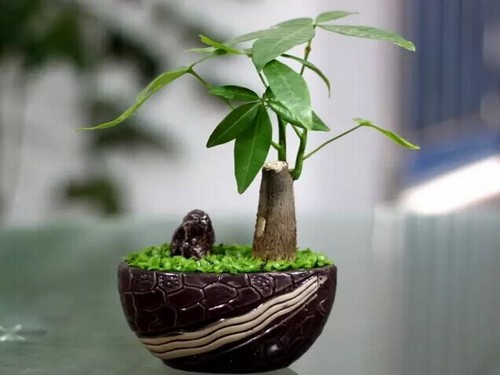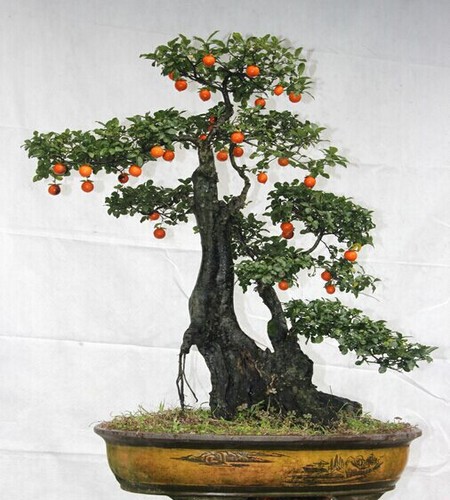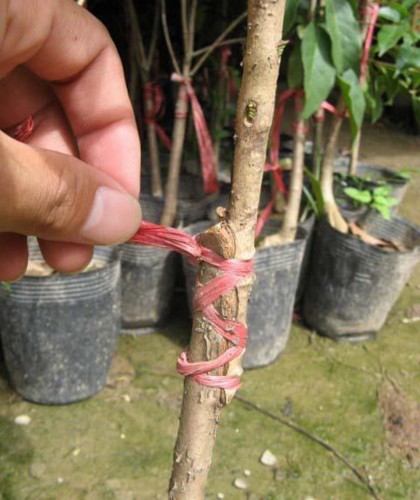Planting method of potted rich tree
Fortune tree has become more and more indoor green plant selection, potted fortune tree growth temperature of 20~30 degrees, winter indoor temperature should be maintained above 10 degrees, suitable for loose, fertile, good drainage of slightly acidic sandy loam, common cultivated varieties have hair leaf fortune tree, big flower fortune tree.

Daily cultivation tips:
Rich trees in spring and autumn fertilization avoid excessive nitrogen fertilizer, avoid excessive plant growth, generally every 15~20 days to apply nitrogen and phosphorus fertilizer once to promote base hypertrophy, watering during growth, not only to keep the pot soil moist, but also to prevent ponding in the pot, pot soil too wet or too dry are detrimental to plant growth, will cause yellow leaves to fall off. Because of the obvious advantage of the top growth of the rich tree, it can be removed from the top to promote the germination of lateral branches. In winter it is placed in a sunny place in a room facing south.
In addition, when planting seedlings, seedlings stem can be arbitrarily woven modeling, so that the stem intertwined growth. The pot is usually turned once a year.
Many flower friends bought hundreds of thousands of pots of rich trees, because improper maintenance caused rotten roots to die, very sad, here we briefly introduce the cuttage propagation of rich trees, do two preparations.
The seedlings propagated and survived by cuttage method are placed in pots, and the pot soil is prepared by mixing 1/3 of rotten leaf soil, garden soil and river sand or peat soil and river sand equally, and applying sufficient decomposed pig manure as base fertilizer, and laying tiles on the bottom of the pot to facilitate drainage. Usually 3 plants are planted in a pot. When planting in the upper pot, do not be too deep, and it is appropriate to expand the basal stem to expose the soil surface. After pouring water on the basin, it is placed in a ventilated shade place for 15 to 20 days, and it is placed in a ventilated half-sunshine and half-shade place.
About Cutting Technology
The seed should be sown immediately after harvest. Cuttings can be taken from sprouting branches in May to June. Cuttings can be taken into sand or steep stones. Pay attention to shade and moisture. Roots can be taken in about one month. Spring can also be used when cutting off the top of the plant branches, cuttings in sand or coarse sand, maintain a certain humidity, about 30 days can take root, but the base of the cuttings difficult to form expanded rhizomes, ornamental value is not as high as seeding seedlings.
Technical points: seedbed finishing select sandy loam plot with deep soil, fertile soil, leeward sun and good irrigation as nursery land, make it into a ridge surface with a width of 1 meter, the length of 10 meters, it is appropriate to move north-south, deeply turn the ridge surface, remove topsoil, smash it, lay a layer of stone gravel with a thickness of 3 cm on the lower layer, lay fresh river sand and slag mixed according to 2:1 on the upper layer, the humidity is to hold it into a group, and it is appropriate to release it. 40% formalin 400 times solution is sprayed on the bed surface, the leaching depth is 3 to 5 cm, and the soil is covered with plastic film for 3 days to disinfect the soil and eliminate pests in the soil.
The cuttings are collected and semi-lignified branches with strong growth, no diseases and insect pests and excellent characteristics are selected. They are cut in cloudy days or windless mornings. The length of the cut is 6 to 7 cm. The lower incision is horseshoe shaped and is located under the leaves or axillary buds. The incision should be smooth and conducive to the formation of healing tissues. Generally each cutting has 2 palmar leaves. Be careful not to damage the leaves to facilitate photosynthesis.
Timely cuttage in late June to early August for insertion, should be in the morning and evening with the cut with the insertion. Before cutting, soak half of cuttings in Standard 3721 rooting solution for 20 to 24 hours, remove and rinse with clean water. Punch holes in the ridge surface with small sticks, insert them along the holes, and seal and compact them. Cuttings can be inserted in a short time, cuttings can be inserted obliquely when they are long, cutting depth is not inclined, generally 3 to 5 cm. Pouring water in time after insertion, righting the wrong cuttings, covering them with plastic cloth and compacting them with soil.
After seedling stage management cuttings must ensure suitable rooting environmental conditions. Generally, the soil temperature is 3℃ to 5℃ higher than the air temperature, the relative humidity of the air in the cutting bed is maintained at 80% to 90%, and the light requirement is 30%. Ventilation 1 to 2 times a day, high temperature from June to August, rapid evaporation of water, in the morning and evening with a fine spray bottle spray water once, temperature maintained between 23℃ and 25℃. After the seedlings survive, timely topdressing, mainly quick-acting fertilizer, nitrogen and phosphorus fertilizer in the early stage, appropriate coordination of nitrogen, phosphorus and potassium in the middle stage, in order to promote the lignification of seedlings in the late stage, spraying 0.2% potassium dihydrogen phosphate before the end of August, stop using nitrogen fertilizer. Callus is usually produced in about 15 days and roots begin to take place in about 30 days.
Rich tree sex likes high temperature moisture and sunshine, every 3 to 5 days, spray water to the leaves with a watering can is conducive to photosynthesis, but also make the branches and leaves more beautiful. The height of the seedlings is generally 40 to 50 cm.
Seedlings transplanted on the pot before tree seedlings to prepare nutrient soil. 3 parts of moldy leaf soil, 2 parts of sand, 4 parts of garden soil and 1 part of fully fermented organic fertilizer are mixed evenly and planted. When transplanting, pay attention not to hurt the tender roots, the depth shall be subject to the original root, irrigate thoroughly after planting, put in a cool place to slow the seedlings, avoid direct sunlight exposure, and water according to the pot soil condition every day.
In addition, we have other planting methods:
Sha Peifa:
1, seedbed finishing: select deep soil, fertile nursery land, adjust to a width of 1 meter of the ridge surface, the length depends on the number of determined, to the north-south direction is appropriate, deep turning of the ridge surface, remove topsoil, smashing solid, the lower layer of a layer of 3 cm thick stone gravel, the upper layer of 10 to 15 cm thick fresh river sand and slag, humidity to hold into a group, release is appropriate. Spray the bed surface with 100-fold dilution of Nisol to a depth of 3 to 5 cm, cover with plastic film for 3 days, and disinfect the soil.
2. Cutting collection: select healthy semi-lignified branches of the current year, cut them in cloudy or windless morning, keep the length of 6 to 7 cm, cut them as inclined planes, located under leaves or axillary buds, and cut them smoothly to facilitate the formation of healing tissues. Generally, each cutting has two palm leaves. Be careful not to hurt the leaves to facilitate photosynthesis.
3, fine cuttage: rich tree in late June to early August for cuttage, should be selected in the summer cloudy days or morning and evening with the cut with the plug. When cutting, use standard code 3721 cutting rooting solution. Punch holes in the ridge surface with small sticks, insert cuttings along the holes, and seal the holes to compact. Cuttings can be inserted in a short time, cuttings can be inserted obliquely when they are long, the cutting depth is not inclined, generally 3 to 5 cm, after insertion, water is poured in time, the wrong cuttings are righted, and covered with plastic cloth.
4, seedling management: ventilation once every 3 days after cuttage, high temperature from June to August, rapid evaporation of water, spraying water once in the morning and evening, temperature maintained between 23 and 25 degrees, humidity is about 80% of the field water capacity. To promote seedling lignification, 0.2% potassium dihydrogen phosphate can be sprayed before the end of August. To prevent fungal infection, thiophanate-methyl or carbendazim can be sprayed on the surface of the bed every 7 days. Callus is usually produced in about 15 days and roots begin to take place in about 30 days.
5. Seedling transplanting: Nutrient soil should be prepared before seedlings are potted, and 3 parts of rotten leaf soil, 1 part of sand and 2 parts of garden soil should be mixed and planted. When transplanting, pay attention not to hurt the roots, the depth shall be subject to the original foundation, pour water thoroughly after planting, put it in the shade, avoid sunlight exposure, water according to the pot soil condition every day, and see dry and wet.
Sowing method:
Rich trees multiply by sowing. Fresh seeds should be used for sowing, picked after maturity in autumn, and seeds should be removed and sown immediately. After sowing, cover with fine soil about 2 cm thick, and then place in semi-shade, keep moist, about 7 days after sowing can germinate. Germination temperature 22-26℃. The seedlings grow to about 25 cm and can be kept densely so that the seedlings grow evenly. Seedlings grow rapidly, seedling stage should be thin nitrogen fertilizer and phosphorus and potassium fertilizer 2-3 times, promote stem base expansion.
Timing: All seasons, spring is best. The seeds can be covered with or without soil, but the soil should not be too deep. It is easier to sprout by watering constantly to keep the humidity of the medium. This method is easier to cultivate beautiful trees. This method reproduces slowly. Seed picking should wait until the fruit skin is yellow or dry before harvesting, otherwise the immature fruit cannot germinate and grow smoothly.
Hydroponics:
Select small soil culture plants growing strong, using root washing method for hydroponic cultivation, it is best to add ceramsite as matrix, which can not only fix the plants, but also facilitate rooting. Water was changed once every 2~3 days at the beginning of hydroponic culture, and new roots could grow after 2 weeks. When the plants are completely adapted to the environment, the nutrient solution of foliage plants is added for maintenance, and the nutrient solution is replaced once every 2 to 3 weeks. If 0.1% potassium dihydrogen phosphate solution can be sprayed regularly on leaves during growth period, it can not only keep oil tender and green, but also promote stem base expansion.
1. Take out the plant, remove the substrate, clean the root with tap water, and cut off all the original soil roots from the root neck;
2. Soak the root base with 1500 times carbendazim or methyl thiophane solution for 10 - 15 minutes, which can eliminate some pathogenic bacteria.
3. Soak the stem base in NAA solution of 200mg/L for 20 - 40 minutes.
4, after taking out and drying, put the rich tree into the hydroponic planting basket and fix it with pebbles or stones. You can start cultivating it. Note that the water for hydroponic cultivation should not be too much, so as to reach the root of the rich tree.
Time: 2019-05-25 Click:
- Prev

How to make the bonsai of golden marbles blossom and bear fruit
I dug the golden billiard stump from the mountain a few years ago, but I haven't seen it blossom and bear fruit in recent years. What is the reason why it no longer blossoms and bears fruit? How can the golden marbles blossom and bear fruit? According to experts, the golden marble stump I dug shows that it is a female plant.
- Next

Grafting technique of potted Osmanthus fragrans
There are many methods of sweet-scented osmanthus grafting, among which the grafting method is commonly used in potted sweet-scented osmanthus in China. Its advantages are: long time for grafting, easy to survive, fast forming and early flowering. The main technical points of osmanthus fragrans are introduced as follows: 1. Cultivate rootstocks.
Related
- Fuxing push coffee new agricultural production and marketing class: lack of small-scale processing plants
- Jujube rice field leisure farm deep ploughing Yilan for five years to create a space for organic food and play
- Nongyu Farm-A trial of organic papaya for brave women with advanced technology
- Four points for attention in the prevention and control of diseases and insect pests of edible fungi
- How to add nutrient solution to Edible Fungi
- Is there any good way to control edible fungus mites?
- Open Inoculation Technology of Edible Fungi
- Is there any clever way to use fertilizer for edible fungus in winter?
- What agents are used to kill the pathogens of edible fungi in the mushroom shed?
- Rapid drying of Edible Fungi

